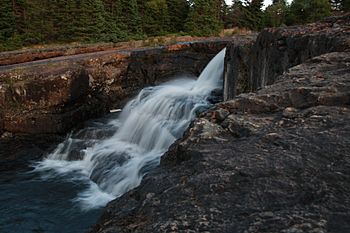Manuels River facts for kids
Quick facts for kids Manuels River |
|
|---|---|

Manuels River viewed from the Manuels River Trail
|
|
| Country | Canada |
| Province | Newfoundland and Labrador |
| Physical characteristics | |
| Main source | Avalon Plateau |
| River mouth | Conception Bay 47°31′38″N 52°57′06″W / 47.52722°N 52.95167°W |
| Length | 10 km (6.2 mi) |
| Basin features | |
| Basin size | 75 km2 (29 sq mi) |
The Manuels River is a beautiful river in Conception Bay South, Newfoundland and Labrador. It starts high up on the Avalon Plateau. The river flows for about 10 kilometres (6 miles). Finally, it empties into the big waters of Conception Bay. You can explore the river by walking on its trails. These trails begin at the Manuels River Hibernia Interpretation Centre. This centre is located right on the Conception Bay Highway.
Contents
Amazing Nature Along Manuels River
The Manuels River has a natural area that collects all its water. This area is called a drainage basin. It covers about 75 square kilometres (29 square miles). This basin stretches south towards the middle of the Avalon Peninsula. Many different plants and animals live in this special area.
Plants and Flowers of the River Valley
Lots of different water plants grow here. These include sedges, tall bull rushes, and bladderwort. The river valley also has many trees and shrubs. These are common in the boreal forests of eastern Newfoundland.
You can see white birch, cherry, and larch trees. They show off amazing fall colors. Fir, black spruce, and juniper trees stay green all winter. They hold the snow like a soft blanket.
More than thirty kinds of wild flowers bloom along the river. Some grow right by the water's edge. Others grow under the shade of the forest trees. Look for yarrow, thistle, and sheep laurel. You might also spot wild mint, goldenrod, and the pretty blue flag iris.
Animals Living Near the River
Both small and large mammals call Manuels River home. Moose, red fox, and barren ground caribou live in the higher parts of the river's watershed. This is where the river starts.
Closer to the river channel or its mouth, you can find other animals. These include hares, squirrels, beavers, and muskrats. They enjoy the water and the plants that grow there.
Birds of Manuels River
Many different birds can be seen along the river. You might spot them flying over the water or resting at its mouth. Some common birds are sandpipers, crows, pigeons, juncos, and gulls.
One special bird is the belted kingfisher. This bird is very important to the area. It is the symbol for the Manuels River Natural Heritage Society.
How Humans Changed the River
Over time, some human activities have changed the river. For example, projects that use water to make electricity have been built. These projects have reduced how much water flows in the river.
Ancient Fossils in the Rocks
The rocks along Manuels River hold amazing secrets from the past. The main fossils found here are Trilobites. These ancient sea creatures lived on the seabed a very long time ago. They left trails as they moved around looking for food.
Trilobites look a bit like sow bugs (also called 'carpenters') or crabs. They were first found along the river in 1874. T.C. Weston from the Geological Survey of Canada made this discovery.
Finding a complete trilobite fossil is rare. But some have been found that are as long as 30 centimetres (12 inches)! Many of the fossils are just pieces of their shells. This is similar to how lobsters today shed their shells.
It is against the rules to take fossil specimens or rock samples from the river. But the Manuels River Natural Heritage Society wants you to learn about them. They offer educational tours to see these wonders from our prehistoric past.
Manuels River Natural Heritage Society
The beauty of Manuels River has inspired a group of volunteers. They formed the Manuels River Natural Heritage Society. Their main goal is to protect the river's natural beauty. They also take care of the walking trails for everyone to enjoy.

